Content Marketing like a Champ
Content Marketing is the way businesses like yours can take the power of the internet and use it to deliver a knockout punch to the competition. You want your business to punch above its weight? Course you do – you’ve got that fire in your belly. Eye o’ th’ tiger!
Because champion content marketing isn’t just about who can spend the most money and punch the hardest – it’s about having great ideas, a killer strategy and fancy footwork.
And content marketing, these days, is an essential skill. It doesn’t matter how great your products and services, nor how powerful your website, if no-one knows it’s there. If you wanna be a contender – you gotta market your business like a champ!
Are you ready to take on the world and win?
Then ring the bell!
Content Marketing Round 1: Eye on the prize
Your first decision needs to be what your goal actually is. What do you want your content marketing to achieve?
Your instinct will be to say “sell more stuff”, but that’s too vague. What are you going to sell? How are you going to sell it? And to whom?
If you cast your mind back to school or college – they will probably have mentioned ‘SMART goals’ to you. Those words (you probably didn’t listen to) were wise words. So, use the SMART method to set yourself some sensible goals. How does it work?
There are various definitions for the ‘SMART’ acronym, but the one that seems most useful for a small business, is…
| S | Specific – focus on one aspect of your business. |
| M | Measurable – number of page views, units sold etc. |
| A | Achievable – be honest about what you can do with your time. |
| R | Realistic – don’t over-reach or you’ll fail. |
| T | Timed – set yourself a reasonable deadline. |
Using this tried and trusted method, you can set some goals for your business that will promote you, build your brand and, ultimately, help sell more stuff.
So, specific short-term goals lead to wider, more profound goals! You have to land that first punch, if you want to go on to win the title.
Deciding on your goals will help you decide on the content marketing and social marketing strategies you need. Let’s look at some of the techniques you can employ…
What is SEO?
The way your favourite search engine works is by sending software ‘bots’ out to the internet to read every website it can find.
Once your website is live, these bots will find it and scan every word, analysing the content, and evaluating it. The search engine operators don’t reveal exactly what criteria they use when ranking a website, but there are certain techniques you can employ that virtually guarantee an improved ranking in other people’s searches.
Collectively, these techniques are known as Search Engine Optimisation (SEO to their friends)

Content Marketing Round 2: How to create punchy SEO
SEO is a group of techniques and tools which help your website find an audience through people’s online searches. Simply put, it’s the way you make your website easier to find.
The quickest way to get your website in front of customers is to pay the search engines to show it to them. But pay-per-click can be expensive.
You can get the same effect for free – with cunning and elegant SEO. Everyone else is doing it so, if you don’t, you’re very unlikely to find customers ‘organically’ – which means without paying for it.
Headline analyser
People are emotional things. We respond to emotional headlines. In the press, a well-turned headline will sell papers. In web-design, a sticky headline will bring people to your website.
So, when you’re writing your blog – give it a title which will grab people’s attention. Obviously, it also has to reflect what the piece is about, otherwise the reader will feel like they’ve been conned and go away, never to return.
But there is nothing wrong with writing a headline that accentuates the positive of what you’re doing. A tool that can help you do this is the Advanced Marketing Institute’s free-to-use Headline Analyser.
If we look at the headline at the top of this section, “How to create punchy SEO”, they have given it an EMV score of 80%.
EMV is what they call ‘Emotional Marketing Value’. That means it should generate a considerable emotional response among people who are searching for information on SEO.
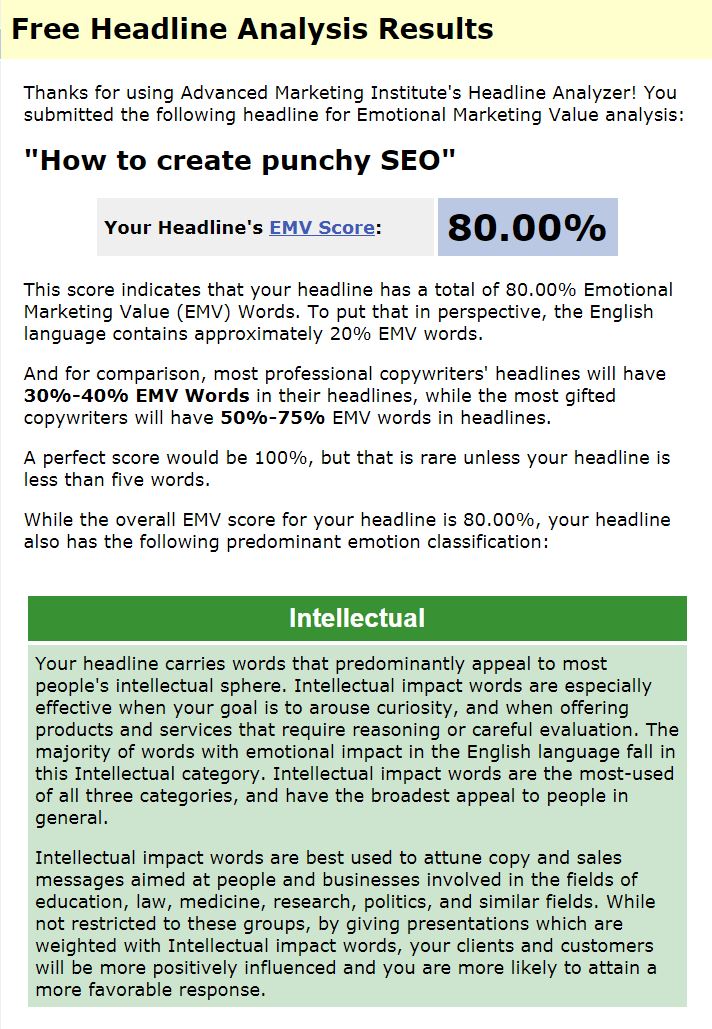
Depending on the sector you’re working in, here are a few trigger words you could include:
- Free
- True
- Secret
- Home-made
- Local
- Fresh
- Easy
- Discover
- Win
- How to
Yo, Adrian
You get the idea, positive verbs and adjectives are great tools to grab a casual reader’s attention. Making an emotional connection with a passing customer is essential to getting them to first to pay attention, then to pay money. To you!
Keyword combinations
Let’s say you’re a garage and you want to promote your MOTs. What do people who want MOTs look for online? The quickest way to find out is to do a search yourself.
Say, for example, you do a Google search for ‘best MOT’ (other search engines are available). The first few results will have the word ‘Ad’ in a green box next to their URL – because these are the businesses that have paid to be seen first. That’s a successful, but very expensive way to market yourself. It’s worth bearing in mind that some people will simply ignore the ads; because they assume that the people advertising will be charging more, in order to pay for the ads.
You don’t want to be doing that.
So, scroll down and you’ll see the ‘organic’ results (the companies which have earned their place on the first search page, rather than paying for it). Google will also helpfully tell what other searches people like you have done. In this case:
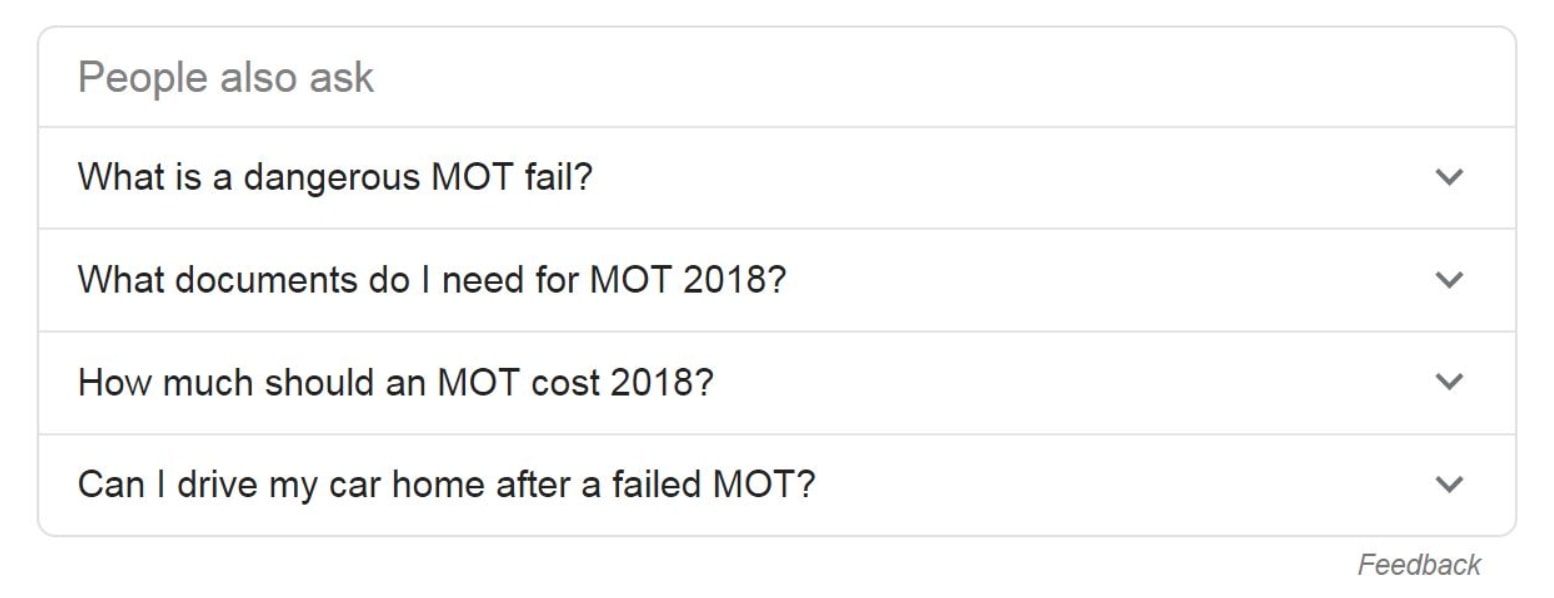
Keep scrolling and, when you get to the bottom of the page, Google has, once again, given you some very helpful insights – a list of other terms people have searched for.
‘Cheap MOTs’ is an obvious one, but did you think of the alternative ‘Best value MOTS’ or ‘MOTs near me’?
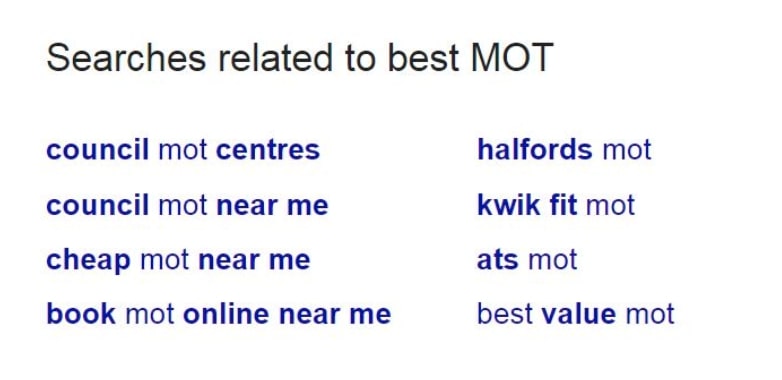
So, a good takeaway from this would be that people search for keywords (or phrases) “cheap”, “value” and “near me”.
Those are your first three keywords. To get the benefit of your keywords, you need to start including them in your content. If you do this, the bots which have found those words on other companies’ websites, will also find them on yours – meaning that you are automatically competing with the other guys.
Keyword stuffing
The search engine bots don’t just look for the words divorced of context; they will judge the whole piece of content.
So, if you’ve just opened up a new steakhouse, for instance, and you want to employ the keyword ‘steakhouse’, you can’t get away with: “Visit our steakhouse, it’s a great steakhouse, the best steakhouse you can steakhouse in the steakhouse of steakhouse with steakhouse”.
A ludicrous example, yes, but it serves to point out that you can’t just repeat the keyword as often as possible. The search bots are wise to this now, it’s called ‘keyword stuffing’ and it’s as bad as having no keywords at all. The search bots will simply ignore your page and refuse to offer it to searchers.
It also makes for tedious reading for the real people you should really be writing for.
Optimising images
People love to look at the pictures on a website. Now, you may think that these pictures – whilst great for your human readers – are no help with those search bots. You’d be wrong.
Each picture has a name. You simply add your keyword to that name. Also, behind the scenes, where human readers don’t see – each picture has an ‘alt text’ description. Again, use your keyword as part of this description.
Using keywords to bring people to you via search engines is worthwhile, but it can be a long game. You really need to use other tools in your Content Marketing arsenal as well!
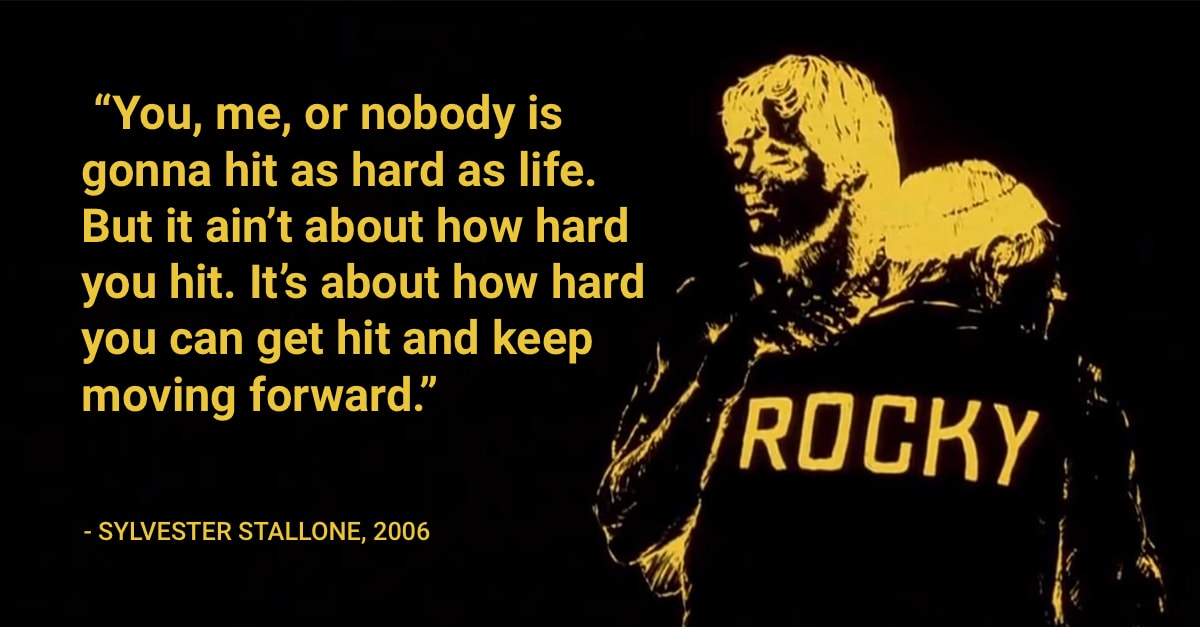
Content Marketing Round 3: The social media double whammy
It’s really important to set up social media accounts for your business. Now we’ll get into some specifics about how you make those social media platforms irresistible! There’s a lot of content marketing you can do through your social media.
Sociable media
The original point of social media was to be an informal way for like-minded people to ‘meet’ and share the things they enjoy with people who aren’t, necessarily, in their physical neighbourhood.
It could have as easily been called ‘Sociable Media’. So, be sociable.
If there is another business whose ethos is similar to yours, show them some support. Like their posts, give them a supportive or constructive comment, share their post if appropriate. There’s a good chance they’ll repay the compliment. Then their followers are aware of you, and your followers are seeing you sharing the love.
Similarly, if there is an event happening in your local area that you think your customers would be interested in – help to spread the word. This is how you use social media to build relationships – both with other businesses and organisations, but also with followers – who are all potential customers.
Be the best
If you’re good at something – don’t be shy, tell people! If you create a great blog or video or podcast about an interesting part of your business – share it. Get it out there via social media.
This can establish your credentials as an expert in your field. Industry leaders don’t get that way by accident, they get that way by being good at what they do, and making sure other people know it! ‘How to’ posts, for example – whether they be written instructions or a video – are brilliant content. Tagged-up properly and shared on social media, a good ‘how to’ post can draw you a lot of attention from potential new customers.
You never know, that next post you create could be the one that goes viral.
Hashtag attack
This is a way of shamelessly hitching your business to a passing bandwagon. If you see a hashtag trending on Twitter that relates – in some tenuous but positive way – to what you do; put out a tweet from your business account that contributes to the story, adds to the joke, offers up a different perspective – and add the hashtag.
People who are following the hashtag will see your post. If they like it, they’ll give you a like, might even follow you and – bingo – you’re building your online community.
Yes, this is shameless self-promotion, so make sure you only do it with hashtags that are positive and relevant to your business.
Sparring with social influencers
Another way of reaching out to new prospects and potential customers is through tagging ‘Influencers’. A Social Media Influencer is, essentially, an internet celebrity. They’re people who have a big following (often it’s a vast following) and whose posts can influence the opinions and behaviour of their many followers.
It’s all about positive association. If you admire a person, you will be inclined to like the things they like.
Clearly, big businesses were quick to capitalise on this, by paying influencers to promote their brands. For years, this seemed to be just part of the informal, do-it-yourself nature of social media. This has now changed and something which is a paid-for promotion has to be clearly labelled as such.
However, it is still possible for a small business to engage with influencers, if you’re clever about it. Business leaders are also influencers, so it isn’t all about trying to attract the attention of celebrities – business influencers would likely be more useful to you, from a branding point-of-view, anyway.
So, how do you attract their attention?
Well, influencers are people too (mostly) and, just like people, they respond to thoughtful, clever, impressive content.
Firstly, be discriminating about the influencers you choose to send your content to. Secondly, be relevant and genuine. Witty doesn’t hurt. If they comment back or even share your post, they’ll only do so if they think it adds to their own brand.
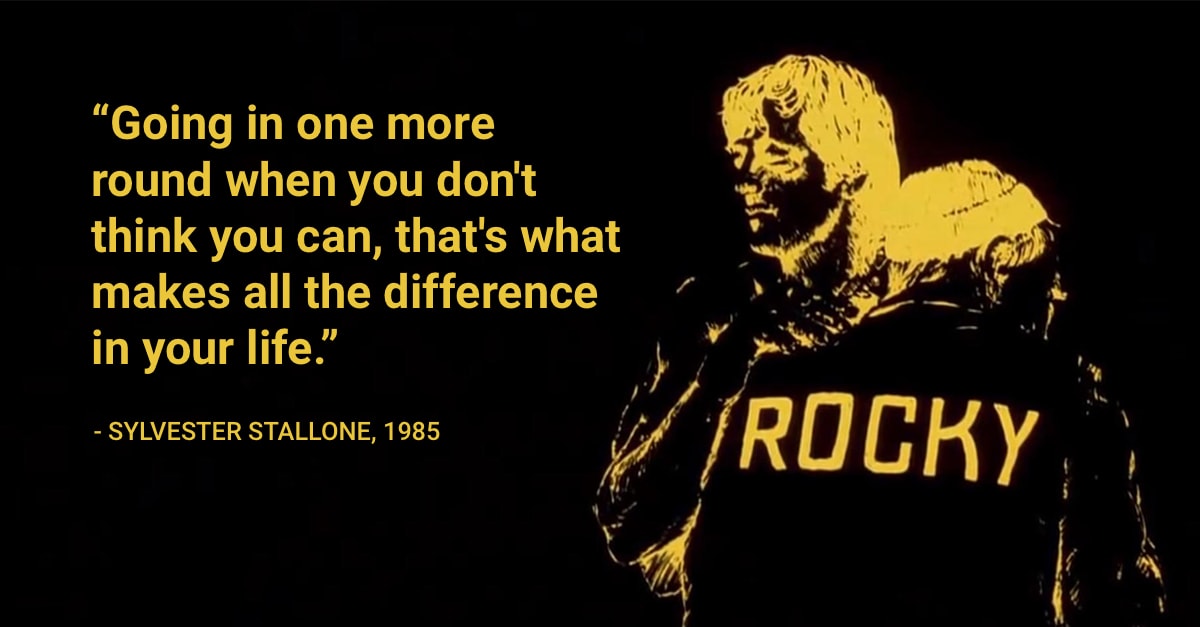
Content Marketing Round 4: Going the distance
It’s worth remembering that none of these strategies are about begging for attention. You’re offering people something – a valuable piece of content – and the reward is that those people will engage with it, like it, share it, respond to it. Their own Friends and Followers will see them do it – and so your reputation will precede you.
But, as a business person, your time is precious – so you have to maximise the impact of every punch you throw, of every piece of content you post.
The only way to know if you’ve struck home is to set ‘Analytics’ on your website and social accounts. This will allow you to measure your performance in real-time. You’ll be able to see how many people are on your site, or engaging with your social posts. You’ll even know where they came from, how long they stay, which pages they visit and how they respond (staying around to read a blog, or buy something – or immediately bouncing back to their search engine).
That’s a great power to have. Back in the days when your main advertising platform was newspapers, they’d tell you how many people bought that day’s paper (then multiply it by their secret formula to create the magical number they called their ‘circulation’) but that didn’t tell you how many people had actually seen your advert, let alone how many had read it.
Nowadays, you are empowered by the Analytics – you can see exactly what works, and what doesn’t, pretty-much in real time.
This means you can adjust your marketing spend accordingly, to ensure your business never ends up on the ropes or throwing in the towel. That’s how you can make your content marketing a total knockout.
The Result: Undisputed champion of the world wide web
The key to lifting the belt as World Class Content Marketer – is having a strategy. By the time you open up your business – and step into the ring of public consciousness – you need to know what you’re doing and why.
Your fight game strategy should include things such as:
- Deciding how you will measure success.
- Researching your customers’ needs.
- Researching your customers’ problems.
- Researching your competitors and figure out how and why they do what they do.
- Listing your keywords.
- Listing your customer’s search terms.
- Defining which types of content will engage your customers.
- Planning your social media marketing.
- Scheduling a calendar of posts / events / targets to hit.
Floating like a butterfly.
Get your strategy right, and you can punch way above your weight. Eye o’ th’ tiger, man, eye o’ th’ tiger!
Now, why – you may be asking yourself – are we, at the Content Marketing Agency, giving away our secrets like this? Simple – because we want to empower your business and get you to the stage that you’re so busy that you don’t have time to do your own content marketing.
Then, you’ll turn to the people who helped you get there – your friends at CMA!

Get CMA in your corner
World-beating strategy, knockout content and undisputed social media mastery – that’s what CMA can offer you. If you wanna know more, we’ll see you down Mickey’s Gym.
